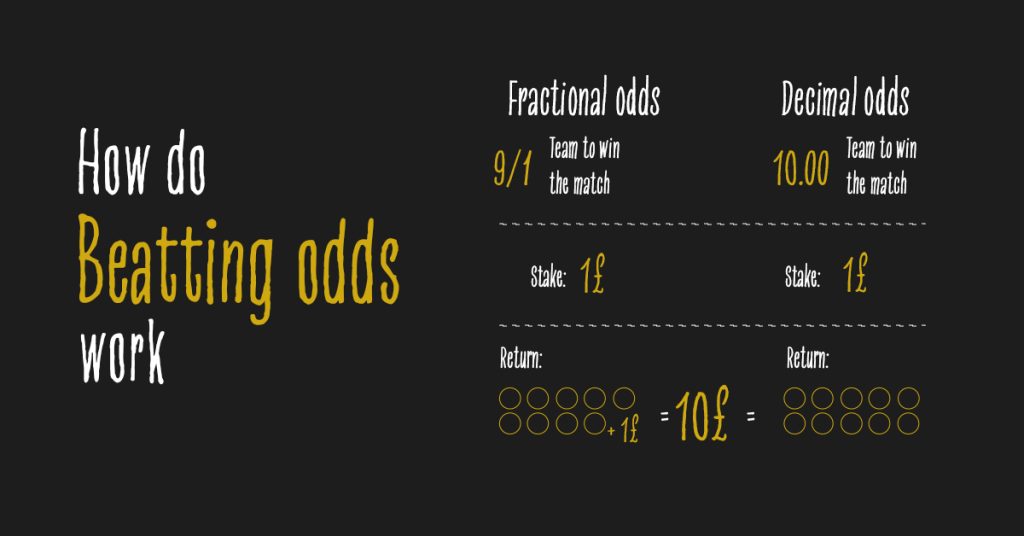
Betting Odds Explained: How Do Betting Odds Work?
The world of betting odds is an exciting place full of endless possibilities, and anyone placing bets should learn how it works. Betting odds are more than just numbers on a screen. The odds help you better understand the probability of a particular event happening and your potential winnings.
The odds help you better understand the probability of a particular event happening and your potential winnings.
Understanding how sports betting odds work may seem intimidating if you’re a beginner. Fear not, though, as our experts have put together this guide that presents a crash course on everything you should know about betting odds and how to leverage them to your advantage.
Betting Odds Explained: What are Betting Odds?
Bookmakers use betting odds to determine the probability of an event or events occurring. Betting odds express the probability of specific outcomes in events like popular sports games, elections, or any other scenario involving multiple possible results.
Betting odds could be conveyed as fractions (1/4), decimals (5.0), or American odds (+145).
How Do Sports Betting Odds Work?
Sports betting is typically presented in one of three formats: decimal, fractional, or American.
Decimal odds represent the total payout, including the original stake.
Fractional odds represent the ratio of the profit to the stake.
American odds are either positive or negative, with positive odds indicating the potential profit from a 100-unit stake and negative odds indicating the amount needed to stake to win 100 units.
In sports, there is often a favourite (a popular, leading team) and an underdog (a less well-known opponent). When these two teams face off, the bookmaker is likely to lower the odds of a popular outcome and raise the odds of a less popular one.
For example, Argentina’s to win the World Cup was 9/5, while France’s win was priced at 7/4. The odds represent that Argentina to win the World Cup is more likely to happen, and they are favourites, while France is the underdog.
Understanding how sports betting odds work is crucial for making informed betting decisions and maximizing potential profits.
Types of Betting Odds: What are Fractional Odds?
UK bookmakers traditionally use the fractional odds format. Fractional odds, also known as British betting odds, are used in the UK and Ireland.
They are expressed as fractions and represent the amount you can win compared to your stake.
For example, if the odds are 5/1, you could win £5 for each £1 you bet. If the odds are 2/5, you could earn £2 for every £5 you bet.
These odds might be bewildering to beginners, but they are simple to comprehend once you become familiar with them.
What are Decimal Odds?
Decimal odds are most commonly used in Europe, Australia, and Canada. Decimal odds also simplify the process of comparing odds for bettors, as it eliminates the need for complex mathematical calculations.
These odds are represented in decimals and show the overall payout, including your stake. A simple example is when the odds are 2.50. In this case, you could earn £2.50 for every £1 you wager.
If you’re a beginner, these odds are easier to understand than fractional odds, as they directly exhibit the total payout.
What are American Odds?
American odds format is mainly used in the United States and Canada but is gaining popularity worldwide. American odds are also called Moneyline odds. American odds are often used in the United States when betting on American sports.
These odds are expressed as a positive or negative number. The negative number indicates when the bookie thinks the event is more likely to happen and the positive number shows the underdog.
For example, let’s say a sportsbook has the following odds for a basketball game:
Team A: -150
Team B: +130
Team A is the favourite in this case, as indicated by the minus number. As a bettor, you would need to wager £150 on Team A to win £100 if they emerge victorious.
If you decide to place a £100 bet on Team B, you will earn £130 if they win the game since they are the underdog.
What is Probability?
In the world of betting odds, probability refers to the likelihood of a particular event happening. It is represented in percentages or odds and enables you to evaluate your potential winnings.
Understanding probability is essential to maximize your profit-making chances in the betting world.
A simple example of a probability is, let’s say you and your friend are flipping a coin. You both bet £1 on whether the coin will land heads or tails. There is a 50% chance of the coin landing on either heads or tails. So you and your friend have an equal chance of winning because there are only two possible results.
What is an Implied Probability?
Probability and implied probability are two distinct concepts.
Probability is a theoretical concept based on mathematical principles and statistical analysis. Probability is simply how likely something is to happen.
In contrast, implied probability is the inferred likelihood of an event happening in the eyes of the bookmaker or the market. This probability reflects how the betting public perceives the event’s chances.
To determine implied probability, you must calculate the reciprocal of the odds and then multiply by 100.
How to calculate implied probability in betting?
Now that you understand odds and probability, it’s crucial to learn how to calculate it if you want to level up your game.
Understanding betting odds and how odds are calculated can give you a significant advantage when it comes to sports betting.
As you already learned, there are three types of odds – fractional, decimal and American. We’ll discuss each betting odds type to help you can use them to calculate the likelihood of an event happening.
Converting fractional odds to implied probability
Fractional odds are when a slash separates two numbers. This type of odds is used mostly in the UK and Ireland.
To calculate the implied probability of fractional odds, you can use the following equation:
Implied probability = denominator / (denominator + numerator) x 100.
We understand this might sound daunting, so let’s simplify things by replacing numbers with letters. Now we have 3/1, which becomes A/B, and the equation looks like this:
Implied probability (%) = B / (A+B).
Here is the calculation:
- 3/1 odds would be calculated as 1/ (3+1) = 0.25, meaning there is a 25% chance of the event happening.
- 7/2 can be calculated as 2/ (7+2) = 0.22, meaning there is a 22% chance of the event happening.
- 1/4 can be calculated as 4 / (4 + 1) = 0.80, meaning there is an 80% chance that the event will happen.
See, it’s not that hard once you get it. Just take some time to practice it, and you’ll be good.
Converting decimal odds to implied probability
Decimal odds are among the most preferable as they are simpler to use. As you already know, they represent the amount that will be returned on a winning bet, including the original stake.
For example, decimal odds of 4.0 mean that for every £1 wagered, the return will be £4.0 (including the £1 stake).
To calculate the implied probability of decimal odds, you can use a simple formula:
(1/ decimal odds) * 100 = implied probability
Example: (1/ 4.0) * 100 = 25%
Converting American odds to implied probability
As mentioned, American odds, or Moneyline odds, are conveyed as a positive or negative number.
Positive American odds show how much profit can be made from a £100 bet, while negative odds indicate how much must be bet to win £100.
That means that we have two separate calculations.
Converting positive American odds
100 / (positive American odds + 100) * 100 = implied probability
Example: 100 / (250+100) * 100 = 28.57%.
Converting negative American odds
Negative American odds / (Negative American odds + 100) * 100 = implied probability
For example, if the odds are -200, the calculation would be:
-200 / (-200 + 100) * 100 = 200/300 * 100 = 66.67%
Therefore, the implied probability of -200 odds is 66.67%.
How Odds Are Determined
Sportsbooks and bookmakers use a multifactorial approach to determine the odds of betting. This reflects the probability of a particular outcome and is subsequently used to compute potential payouts for wagers.
Factors Affecting Betting Odds
One of the most salient determinants of odds is the performance of a team or athlete. In this context, the sportsbook scrutinizes various factors, including past performance, current form, injuries, and other relevant information, to compute the probability of a particular outcome.
Teams or athletes that boast a formidable track record and are currently in good form will be accorded higher odds of success than those with a poorer record or who are out of form.
Another variable that can impact the odds is public perception. If a particular team or athlete is popular or commands a sizable fan base, the sportsbook may adjust the odds in their favour with the aim of enticing more bets.
Still, bookmakers must also factor in the amount of money being placed on either side of the wager to ensure the books are balanced and the risk minimized.
Weather conditions and other environmental factors can also come into play when determining the odds. For example, when a football match is played under challenging weather conditions like heavy rain or snow, the team better equipped to handle such conditions may be awarded lower odds of success.
Algorithms and statistical analysis also play an integral part in setting the odds. The sportsbook employs data analysis to compute the probability of a particular outcome based on various factors such as team performance, public perception, and external factors. The outcome of this analysis informs the setting of odds that reflect the likelihood of a particular outcome, which can be adjusted in response to new information as it emerges.
How to Read Betting Odds
So far, we’re having amazing progress, but it’s time to add one more thing to the equation. You already know how to calculate your betting odds to implied probability, but if you want to boost your knowledge, you’ll have to learn how to read odds.
It might sound frightening at first, but that’s why we’re here, so don’t worry. Once you get used to it, you’ll be a pro, and you’ll place bets with ease, and who knows, you might even win big.
Now let’s get started and teach you how to calculate your potential winnings.
How To Read Fractional Odds
To calculate your potential winnings with fractional odds, you can use the following equation:
((stake/second number) x first number) + stake = total payout
If you bet £10 on a 4/1 bet, your calculation would look like this:
((£10/1) x 4) + £10) = £50
How To Read Decimal Odds
Decimal betting odds are one of the most popular odds types for a reason – they are easier to work with. You should look for one thing only – a bigger number, as this means a larger return.
To calculate your potential winnings with decimal odds, you can use the following formula:
Potential Winnings = Stake x Odds
For example, if you bet £10 at odds of 2.00, your potential total payout would be 10 x 2.00 = £20.
How To Read American Odds
To calculate your potential winnings with American odds, you can use the following formula:
Potential Winnings = (Stake x Odds) / 100
For example, if you bet £50 on a +150 underdog and they win your potential winnings would be:
Potential Winnings = £50 x 150) / 100 = £75
But let’s say you’re presented with odds -150 favourite. In this case, you will have to wager an amount of £150 to receive a return of £250. This return includes your initial stake of £150 and an additional profit of £100.
How to Use Odds to Your Advantage
Using odds to make smarter bets requires more than just knowing their different types. To improve your betting success, you need to use odds in a way that works to your advantage. The key here is understanding implied probability and making clever comparisons between various bookmakers’ offers.
Use the Implied Probability To Your Advantage
As you should already know, the implied probability is the likelihood of a specific outcome happening based on the odds. To find the implied probability of fractional odds, divide the denominator by the total of the numerator and denominator, then multiply by 100. For example, if the odds are 5/1, the implied probability is 16.67% (1 / (5+1) x 100).
Compare Different Odds
Another way to use odds in your favour is by comparing the odds offered by different bookmakers.
Looking around for the best odds can improve your chances of winning and make your profits bigger.
Learn How To Hedge
You can also use odds to reduce your risk by placing multiple bets on the same event, also known as hedging.
For example, if you bet on a team to win using fractional odds, you can hedge your bet by also placing a bet on the same team to draw using decimal odds.
Best Betting Sites UK
At Mister Betting, you can find some of the best betting sites available online. They have carefully selected and reviewed a range of reputable bookmakers and online casinos, ensuring that their users have access to top-quality platforms for their betting needs.
The betting industry is lavished with different betting sites, and Mr Betting understands that finding a trustworthy and reliable betting site can be a daunting task, especially for new players. That’s why we have done the hard work for you, so here are just some of the best betting sites you can try:
- William Hill – One of the most established and reputable bookmakers in the world, offering a wide range of markets.
- Sky Bet – Offers competitive odds, a user-friendly platform, and generous promotions for new and existing customers.
- Betway – A popular choice for eSports betting, with a sleek and modern website and a wide range of sports markets.
- 888Sport – Provides excellent odds and a vast selection of betting options, especially in football and horse racing, with innovative features like Bet Builder.
- Betfair – Betfair is known for being a betting exchange, but as of 2012, it also has a sportsbook. There are more than thirty-five different games covered, from football and horse racing to cycling and futsal, and the overall payout is 93%.
FAQs
How do I know which type of odds my bookmaker uses?
You can usually choose your preferred odds format when setting up your account.
Can odds change after I place my bet?
Yes, odds can change depending on the volume of bets placed and the probability of an event happening.
What factors affect betting odds?
Betting odds are influenced by a range of factors, including form and performance of teams/players, injuries and suspensions, weather conditions, home advantage, head-to-head records, and bookmaker margins.
How do I calculate my potential payout?
To calculate your potential payout, you simply multiply your stake by the odds. For example, if you bet £10 on odds of 2.5, your potential payout would be £25 (£10 x 2.5).
What does it mean when betting odds are negative?
When betting odds are negative, it means that the outcome of the event is more likely to happen than not. In other words, a negative betting odd indicates that the bet is favoured to win, and the payout may be lower than the original wager.












